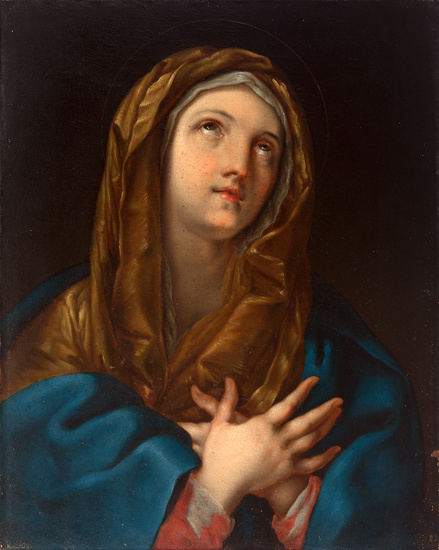Italian School of the 17th century Circle of GUIDO RENI
Italian School of the late 17th century. Circle of GUIDO RENI (Calvenzano di Vergato, Bologna, 1575 - Bologna, 1642).
"Dolorosa".
Oil on canvas. Re-drawn.
Size: 61 x 48 cm; 72 x 60 cm (frame).
Judging by the formal and stylistic characteristics, the present work was executed by a painter from the Guido Reni circle, the undisputed master of Roman-Bolognese classicism together with Albani and Domenichino. The Virgin Mary is depicted as the Sorrowful Virgin Mary, portrayed against a neutral background with a powerful diagonal spotlight illuminating the figure. Formally, Mary is depicted bust-length, raising her gaze towards the source of the light, in ecstasy and with a subtle, elegant gesture.
The undisputed master of Roman-Bolognese classicism along with Albani and Domenichino, Guido Reni was undoubtedly the best of the three. Closely linked to the Carracci family and to the city of Bologna, they all had a similar career. They trained in Bologna with Denys Calvaert, and then went on to the Accademia degli Incamminati, directed by Ludovico Carraci. In 1600 Reni arrived in Rome, where he worked with Annibale Carracci in the Galleria Farnese. His best period began in these years; in 1609, on Annibale's death, Reni became the head of the classicist school. In the city he was the protégé of Scipione Borghese, the future Pope Paul V, for whom the painter produced one of his most important works, "La Aurora" (Palazzo Rospigliosi). It reveals something that would always be characteristic of Reni's style, his admiration for ancient sculpture. Starting from classical statues, he developed an ideal of beauty and perfection that would be greatly admired by subsequent painters. In 1614 he returned to Bologna for good. Reni's style evolved in a clear direction, becoming more and more sculptural and cold, more and more fully classicist. His mature work was characterised by a cold, silvery palette. Finally, from the 1930s onwards, his style became sketchy, with an unfinished appearance and a tendency towards monochrome, of great interest from a technical as well as a formal point of view.Guido Reni is currently represented in the most important art galleries all over the world, including the Prado Museum, the Hermitage, the Louvre, the Metropolitan Museum in New York and the National Gallery in London, among many others.
COMMENTS
Reentelado.
View it on
Estimate
Time, Location
Auction House
Italian School of the late 17th century. Circle of GUIDO RENI (Calvenzano di Vergato, Bologna, 1575 - Bologna, 1642).
"Dolorosa".
Oil on canvas. Re-drawn.
Size: 61 x 48 cm; 72 x 60 cm (frame).
Judging by the formal and stylistic characteristics, the present work was executed by a painter from the Guido Reni circle, the undisputed master of Roman-Bolognese classicism together with Albani and Domenichino. The Virgin Mary is depicted as the Sorrowful Virgin Mary, portrayed against a neutral background with a powerful diagonal spotlight illuminating the figure. Formally, Mary is depicted bust-length, raising her gaze towards the source of the light, in ecstasy and with a subtle, elegant gesture.
The undisputed master of Roman-Bolognese classicism along with Albani and Domenichino, Guido Reni was undoubtedly the best of the three. Closely linked to the Carracci family and to the city of Bologna, they all had a similar career. They trained in Bologna with Denys Calvaert, and then went on to the Accademia degli Incamminati, directed by Ludovico Carraci. In 1600 Reni arrived in Rome, where he worked with Annibale Carracci in the Galleria Farnese. His best period began in these years; in 1609, on Annibale's death, Reni became the head of the classicist school. In the city he was the protégé of Scipione Borghese, the future Pope Paul V, for whom the painter produced one of his most important works, "La Aurora" (Palazzo Rospigliosi). It reveals something that would always be characteristic of Reni's style, his admiration for ancient sculpture. Starting from classical statues, he developed an ideal of beauty and perfection that would be greatly admired by subsequent painters. In 1614 he returned to Bologna for good. Reni's style evolved in a clear direction, becoming more and more sculptural and cold, more and more fully classicist. His mature work was characterised by a cold, silvery palette. Finally, from the 1930s onwards, his style became sketchy, with an unfinished appearance and a tendency towards monochrome, of great interest from a technical as well as a formal point of view.Guido Reni is currently represented in the most important art galleries all over the world, including the Prado Museum, the Hermitage, the Louvre, the Metropolitan Museum in New York and the National Gallery in London, among many others.
COMMENTS
Reentelado.



